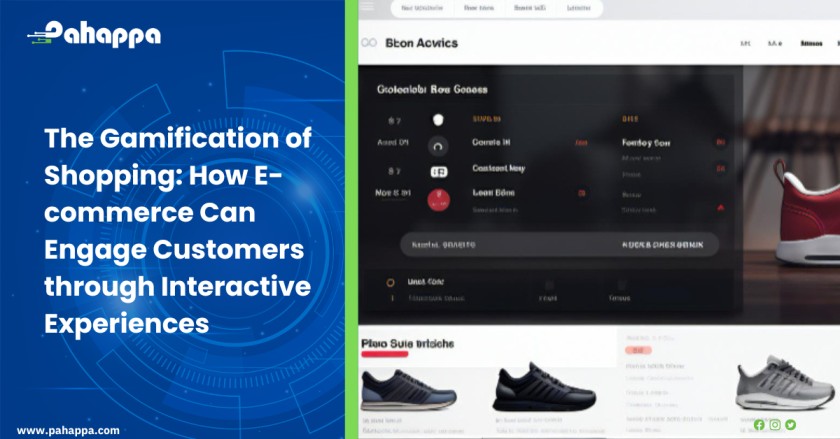Once upon a time in the realm of commerce, the act of shopping was a straightforward transaction, a mere exchange of goods for currency. However, as the digital age unfolded, a new chapter emerged – one where e-commerce took center stage, transforming the shopping experience into an interactive and engaging journey. Imagine a small business, nestled in the competitive landscape of e-commerce, seeking not just to sell products but to captivate its audience through a unique adventure. This tale mirrors a growing trend: the gamification of shopping. According to recent statistics, businesses that incorporate gamified elements into their e-commerce platforms witness a 47% increase in user engagement. As we delve into the narrative of how small and medium-sized enterprises (SMEs) are turning their virtual storefronts into immersive landscapes, we explore the potential impact of the gamification of shopping.
What is E-commerce Gamification?
E-commerce gamification refers to the incorporation of game-like elements, mechanics, and design principles into the online shopping experience. The goal is to make the process of browsing, selecting, and purchasing products more engaging, enjoyable, and interactive for consumers. By drawing inspiration from games, e-commerce gamification aims to increase customer participation, foster loyalty, and enhance overall user satisfaction.
Here are some key elements of e-commerce gamification:
- Loyalty Programs with Gamified Elements
Loyalty programs are enhanced with gamified features such as point systems, badges, levels, and rewards. Customers earn points for various interactions like making purchases, writing reviews, or sharing products on social media. Advancing through levels or achieving milestones unlocks exclusive discounts, special promotions, or unique privileges, motivating customers to stay engaged and loyal.
- Interactive Product Discovery
Gamification is applied to the product discovery process through interactive features. This can include quizzes, product recommendations based on user preferences, virtual try-ons, or personalized product tours. By making the exploration of products more interactive and entertaining, businesses aim to keep customers engaged and interested in their offerings.
- Social Media Challenges and Contests
E-commerce gamification extends to social media platforms with challenges and contests. Customers are encouraged to participate in activities such as sharing photos of their purchases, creating user-generated content, or competing in brand-related challenges. This not only increases brand visibility but also fosters a sense of community among customers.
- Gamified Checkouts and Discounts
The checkout process is gamified by introducing elements like spin-the-wheel discounts, mystery boxes, or progress bars. Customers may receive surprise discounts or bonuses during the checkout stage, adding an element of excitement and encouraging them to complete the purchase. This gamified approach aims to reduce cart abandonment and enhance the overall shopping experience.
- Virtual Rewards and Achievements
Virtual rewards and achievements, such as badges, trophies, or virtual currency, are introduced to recognize and celebrate customer interactions and milestones. These gamified elements create a sense of accomplishment and provide customers with tangible recognition for their engagement. Businesses may use these rewards to motivate repeat purchases and sustained interaction.
How E-commerce Can Engage Customers through Interactive Experiences
- Gamified Loyalty Programs
Implement gamified elements in loyalty programs to make them more engaging. Introduce point systems, badges, and rewards for various interactions such as purchases, reviews, or social media shares. Allow customers to unlock exclusive discounts or access to limited-time promotions as they progress through different levels. This not only encourages repeat business but also adds an element of fun to the loyalty program.
- Interactive Product Discovery
Make the process of exploring products more interactive and personalized. Integrate features like quizzes, virtual try-ons, or product configurators that allow customers to visualize products in different settings. Implement personalized recommendations based on their preferences and purchase history. The goal is to create a more enjoyable and immersive product discovery experience that goes beyond traditional browsing.
- Social Media Challenges and Contests
Leverage social media platforms to create interactive challenges and contests. Encourage customers to share photos of their purchases, participate in themed challenges, or generate user-generated content related to your products. This not only boosts brand visibility on social media but also fosters a sense of community among your customers. Offering prizes or discounts for participation adds an extra incentive.
- Gamified Checkouts and Discounts
Infuse excitement into the checkout process by introducing gamified elements. Implement features like spin-the-wheel discounts, mystery boxes, or limited-time flash sales during the checkout stage. This not only makes the payment process more enjoyable but also encourages customers to complete their transactions. Gamified discounts can create a sense of urgency and surprise, enhancing the overall shopping experience.
- Virtual Rewards and Achievements
Recognize and reward customer engagement through virtual rewards and achievements. Introduce badges, loyalty points, or exclusive status levels based on their interactions and purchase history. Celebrate milestones with personalized messages or offers. This gamified approach not only motivates customers to stay engaged but also provides a sense of accomplishment and recognition.
- Interactive Customer Support
Implement interactive customer support features such as live chat, chatbots, or virtual assistants. Enable customers to ask questions, seek product recommendations, or receive real-time assistance during their shopping journey. Interactive support not only enhances the overall customer experience but also helps in addressing concerns promptly, leading to increased trust and satisfaction.
- Augmented Reality (AR) Experiences
Integrate augmented reality experiences that allow customers to visualize products in their real-world environment. For example, furniture or clothing retailers can enable customers to see how items look in their homes or on themselves through AR applications. This interactive and immersive experience enhances confidence in purchasing decisions.
- User-Generated Content Integration
Encourage and showcase user-generated content on your platform. Implement features that allow customers to upload photos, write reviews, or share their experiences with purchased products. This not only adds authenticity to your brand but also engages other potential customers who value peer recommendations.
The rise of the gamified shopping experience is no fairy tale. It’s a revolution transforming online businesses, and yours can be a part of it. Don’t let your e-commerce platform be just another digital storefront. Turn it into a captivating adventure, a playground of engagement, a land of rewards and interactive delight. Ready to write your own e-commerce success story? Contact us today and let’s explore how gamification can be your secret weapon. Together, we’ll design a website that doesn’t just sell products – it captures hearts and minds, one click at a time.











